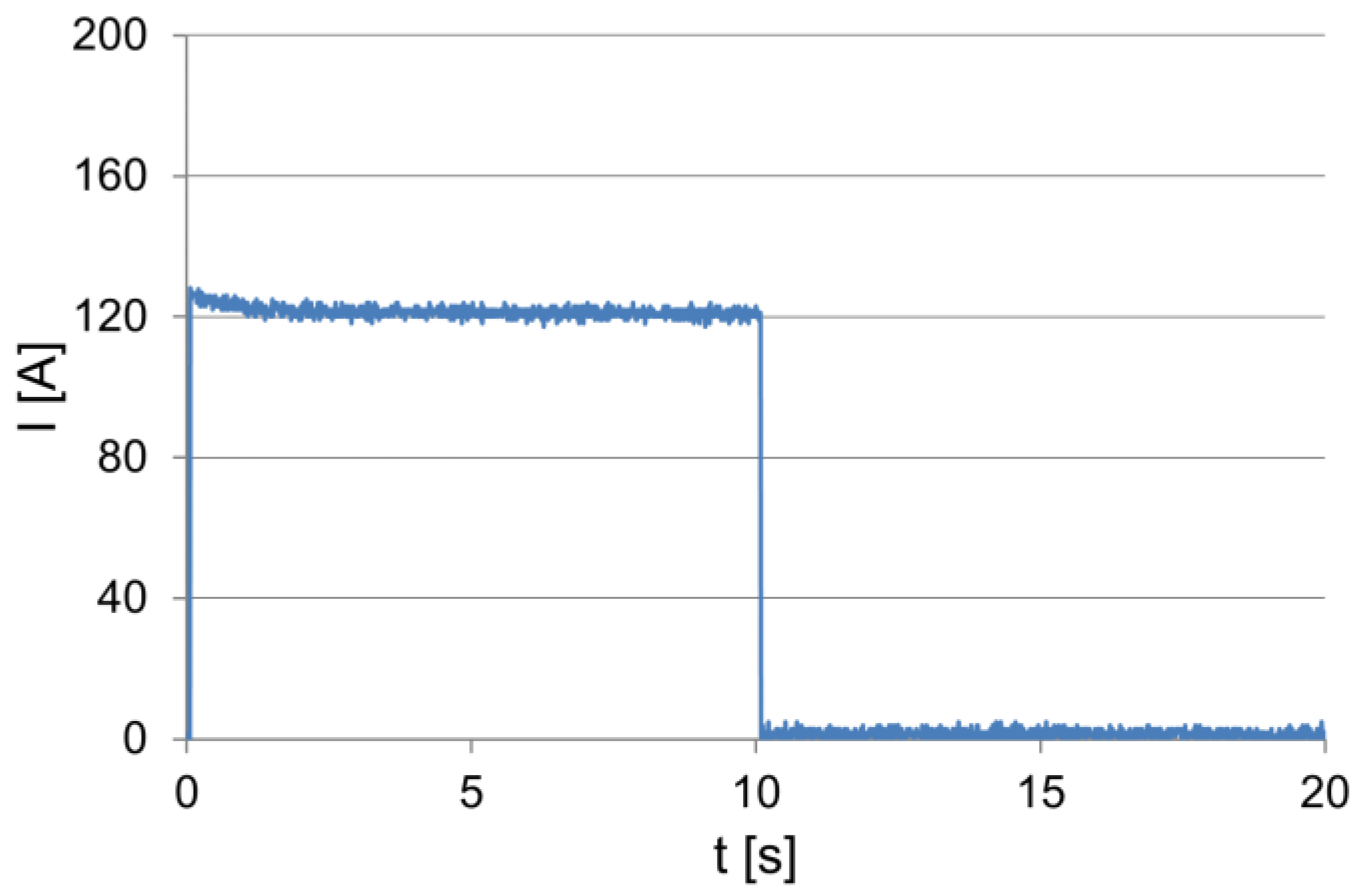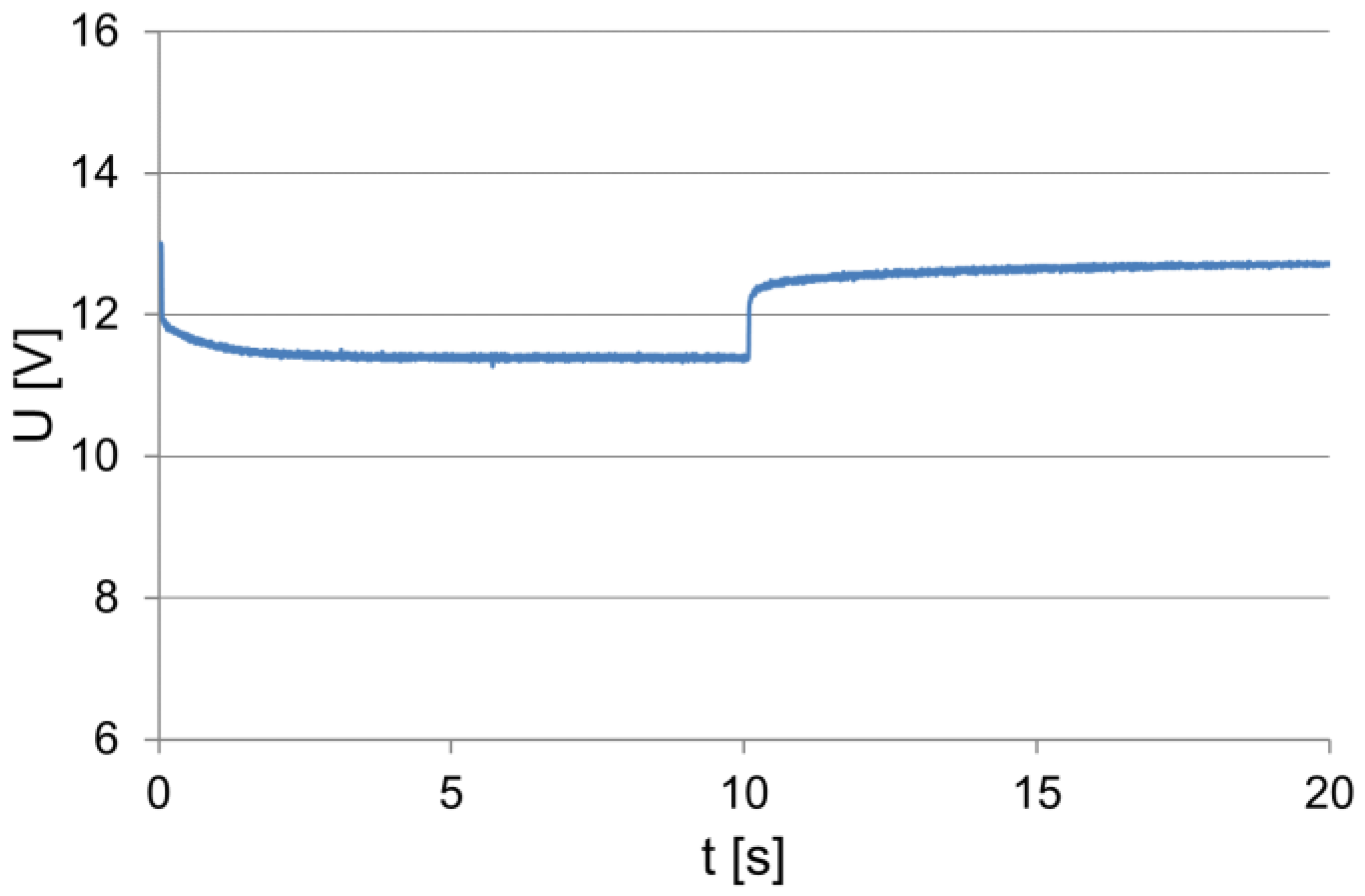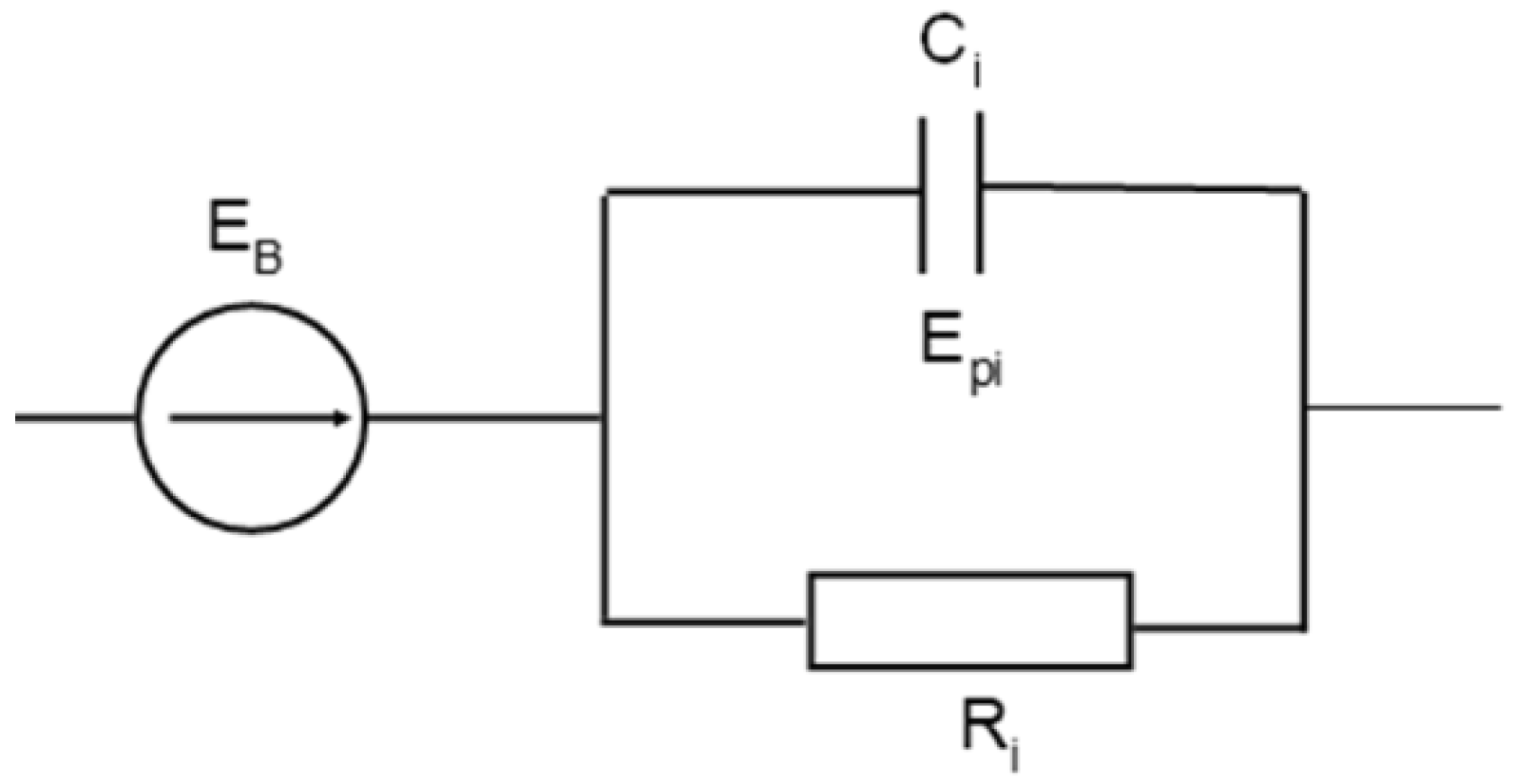Description of Acid Battery Operating Parameters
Abstract
:1. Introduction
2. Materials and Methods
- The own noise of the measuring system;
- Interference from the external electricity network;
- Quantization errors of the measuring system.
3. Results
3.1. Stationary Operating Characteristics of an Acid Battery
- xik—the coded value of the independent variable;
- xi—the independent variable subjected to the coding;
- xio—the central value, determined by the Equation (3);
- Δxi—the unit of variation of the independent variable subjected to the coding.
- The battery nominal capacity: Q = 110 and 170 Ah;
- The current: I = 84 and 224 A;
- The temperature: T = 0 and +22 °C
- The battery condition (state of charge): k = 0.7 and 1.
3.2. Acid Battery Non-Stationary Operating Characteristics
- It is a function commonly used in science and technology;
- It is easy to interpret;
- It enables the development, through the interpretations, of a structural model of the object that undergoes an exponential response to a step extortion and its analytical description.
- Rs—battery resistance in the steady operating state;
- Rv—amplitude of the variable resistance component of the battery;
- τ—time constant of the change process of the internal resistance.
3.3. Battery Structural Model
4. Discussion
5. Conclusions
- Regression methods that enable general, symbolic, and formal descriptions of the test results play an important role in the study of the characteristics and parameters of the acid battery structure.
- The static characteristics of the battery as a function of the essential independent parameters, such as rated capacity, state of charge, current intensity, and electrolyte temperature, are linear under a wide range of usable operating conditions.
- Under dynamic operating conditions, the battery is a complex control object with time-varying characteristics and properties of an equivalent structural electrical circuit. This is expressed by the necessity to include two or even three RC circuits in its structure.
- The determined stationary and dynamic model enables determination of the influence on the operation of the starter and the parameters of driving the crankshaft of the internal combustion engine by the battery under specific operating conditions.
- Estimation of the time constants of dynamic voltage characteristics of the battery enables the determination of its operator and spectral transmittance, and evaluation of the impact of the dynamic characteristics, not only on the functioning of the battery, but also on the internal combustion engine starting system and its crankshaft drive characteristics.
- The dynamic characteristics of the load phase and voltage stabilization after switching off the load are significantly different, and the equivalent circuit has two or three RC circuits, respectively.
- Significant differences in the load phase and voltage stabilization characteristics indicate a significant differentiation in the causes of the appearance and disappearance of the imbalance of the loaded battery and after the load is turned off.
- The determination procedures, especially of the dynamic characteristics, are laborious and require precise separation of the variable, dynamic part from the recorded course. It is possible to achieve high accuracy in determining the characteristics, as assessed by the value of the determination coefficient, which can be as high as 0.99.
- The criterion for assessing the accuracy of determining the dynamic characteristics may be the value of the determination coefficient, both in the range of the value of the stable voltage and in the time intervals of the exponential function with a specific value of the time constant.
Funding
Institutional Review Board Statement
Informed Consent Statement
Data Availability Statement
Conflicts of Interest
References
- Ceraolo, M. New dynamical models of lead-acid batteries. IEEE Trans. Power Syst. 2000, 15, 1184–1190. [Google Scholar] [CrossRef] [Green Version]
- Jackey, R.A. A Simple, Effective Lead-Acid Battery Modeling Process for Electrical System Component Selection; SAE International: Warrendale, PA, USA, 2007. [Google Scholar]
- Droździel, P. Impact of selected operation conditions of a car combustion engine on its start-up parameters. Eksploat. Niezawodn. Maint. Reliab. 2003, 4, 22–30. [Google Scholar]
- Enache, B.-A.; Constantinescu, L.-M.; Lefter, E. Modeling aspects of an electric starter system for an internal combustion engine. In Proceedings of the 2014 6th International Conference on Electronics, Computers and Artificial Intelligence (ECAI), Bucharest, Romania, 23–25 October 2014; pp. 39–42. [Google Scholar]
- Kasprzyk, L. Modelling and analysis of dynamic states of the lead-acid batteries in electric vehicles. Eksploat. Niezawodn. Maint. Reliab. 2017, 19, 229–236. [Google Scholar] [CrossRef]
- Pszczółkowski, J. Rozruch silnika tłokowego jako proces diagnostyczny. Diagnostyka 2002, 27, 48–53. [Google Scholar]
- Chacón, H.E.A.; Banguero, E.; Correcher, A.; Pérez-Navarro, Á.; Morant, F. Modelling, Parameter Identification, and Experimental Validation of a Lead Acid Battery Bank Using Evolutionary Algorithms. Energies 2018, 11, 2361. [Google Scholar] [CrossRef] [Green Version]
- Lee, S.; Cherry, J.; Safoutin, M.; McDonald, J. Modeling and Validation of 12V Lead-Acid Battery for Stop-Start Technology. SAE Tech. Pap. Ser. 2017, 1. [Google Scholar] [CrossRef]
- Dost, P.; Sourkounis, C. Generalized Lead-Acid based Battery Model used for a Battery Management System. Athens J. Technol. Eng. 2016, 3, 255–270. [Google Scholar] [CrossRef]
- Mohsin, M.; Picot, A.; Maussion, P. Lead-acid battery modelling in perspective of ageing: A review. In Proceedings of the 2019 IEEE 12th International Symposium on Diagnostics for Electrical Machines, Power Electronics and Drives (SDEMPED), Toulouse, France, 27–30 August 2019; pp. 425–431. [Google Scholar]
- Park, C.H.; Yoon, J.H.; Choi, J.D. A Quantitative Study for Critical Factors of Automotive Battery Durability. In Automotive Electronics Reliability; SAE International: Warrendale, PA, USA, 2010; pp. 187–192. [Google Scholar]
- Barré, A.; Suard, F.; Gérard, M.; Montaru, M.; Riu, D. Statistical analysis for understanding and predicting battery degradations in real-life electric vehicle use. J. Power Sources 2014, 245, 846–856. [Google Scholar] [CrossRef]
- Tseng, K.-H.; Liang, J.-W.; Chang, W.; Huang, S.-C. Regression Models Using Fully Discharged Voltage and Internal Resistance for State of Health Estimation of Lithium-Ion Batteries. Energies 2015, 8, 2889–2907. [Google Scholar] [CrossRef] [Green Version]
- Korotunov, S.; Tabunshchyk, G.; Okhmak, V. Genetic Algorithms as an Optimization Approach for Managing Electric Vehi-cles. Charging in the Smart Grid. Available online: http://ceur-ws.org/Vol-2608/paper15.pdf (accessed on 26 October 2021).
- Shen, Y. Supervised chaos genetic algorithm based state of charge determination for LiFePO4 batteries in electric vehicles. In Proceedings of the 2nd International Conference on Advances in Materials, Machinery, Electronics (AMME 2018), Xi’an, China, 20–21 January 2018; AIP Publishing: College Park, MD, USA, 2018; Volume 1955, p. 040050. [Google Scholar]
- Loukil, J.; Masmoudi, F.; Derbel, N. A real-time estimator for model parameters and state of charge of lead acid batteries in photovoltaic applications. J. Energy Storage 2021, 34, 102184. [Google Scholar] [CrossRef]
- Wang, Z.-H.; Hendrick; Horng, G.-J.; Wu, H.-T.; Jong, G.-J. A prediction method for voltage and lifetime of lead-acid battery by using machine learning. Energy Explor. Exploit. 2019, 38, 310–329. [Google Scholar] [CrossRef]
- Demirci, O.; Taskin, S. Development of measurement and analyses system to estimate test results for lead-acid starter batteries. J. Energy Storage 2021, 34, 102172. [Google Scholar] [CrossRef]
- Křivík, P.; Vaculík, S.; Bača, P.; Kazelle, J. Determination of state of charge of lead-acid battery by EIS. J. Energy Storage 2019, 21, 581–585. [Google Scholar] [CrossRef]
- Raji, S.; Kubba, Z.M. Design and Simulation of Lead-Acid Battery. J. Al-Nahrain Univ. Sci. 2020, 23, 39–44. [Google Scholar] [CrossRef]
- Laadissi, M.; Filali, A.; Zazi, M.; Ballouti, A. Comparative Study of Lead Acid Battery Modelling. ARPN J. Eng. Appl. Sci. 2006, 13, 4448–4452. [Google Scholar]
- Shi, M.; Yuan, J.; Dong, L.; Zhang, D.; Li, A.; Zhang, J. Combining physicochemical model with the equivalent circuit model for performance prediction and optimization of lead-acid batteries. Electrochim. Acta 2020, 353, 136567. [Google Scholar] [CrossRef]
- Jiang, S. A Parameter Identification Method for a Battery Equivalent Circuit Model. In SAE Technical Paper 1; SAE International: Warrendale, PA, USA, 2011. [Google Scholar] [CrossRef]
- Lach, J.; Wróbel, K.; Wróbel, J.; Podsadni, P.; Czerwiński, A. Applications of carbon in lead-acid batteries: A review. J. Solid State Electrochem. 2019, 23, 693–705. [Google Scholar] [CrossRef] [Green Version]
- Zhuravsky, B.V.; Zanin, A.; Kvasov, I.N. Simulation of the electric starter system of the internal combustion engine start-up to study the impact on its operation of the pre-start battery discharge. J. Phys. Conf. Ser. 2020, 1441, 012030. [Google Scholar] [CrossRef] [Green Version]
- Dyga, G.; Pszczółkowski, J. Plan eksperymentu identyfikacji modelu napięcia obciążonego akumulatora kwasowego. Technika Transportu Szynowego. 2015, 12, 1843–1849. [Google Scholar]
- Chang, W.-Y. The State of Charge Estimating Methods for Battery: A Review. ISRN Appl. Math. 2013, 2013, 953792. [Google Scholar] [CrossRef]
- Nikdel, M. Various battery models for various simulation studies and applications. Renew. Sustain. Energy Rev. 2014, 32, 477–485. [Google Scholar] [CrossRef]
- Moubayed, N.; Kouta, J.; El-Ali, A.; Dernayka, H.; Outbib, R. Parameter identification of the lead-acid battery model. In Proceedings of the 2008 33rd IEEE Photovolatic Specialists Conference, San Diego, CA, USA, 11–16 May 2008; pp. 1–6. [Google Scholar] [CrossRef]
- Pszczółkowski, J.; Dyga, G. Dwuwymiarowe liniowe zależności funkcyjne napięcia akumulatora kwasowego. Logistyka 2014, 6, 8984–8995. [Google Scholar]








| Variable | Characteristic Value | ||
|---|---|---|---|
| Central Value | Unit of Variation | Coded Variable | |
| Capacity: Q | 140 | 30 | |
| Current: I | 154 | 70 | |
| Temperature: T | 11 | 11 | |
| SoC: k | 0.85 | 0.15 | |
| Voltage: U | – | – | y = U |
| Number | x0 | x1 | x2 | x3 | x4 | ymean |
|---|---|---|---|---|---|---|
| 1 | +1 | +1 | +1 | +1 | +1 | 11.32 |
| 2 | +1 | +1 | +1 | +1 | −1 | 11.03 |
| 3 | +1 | +1 | +1 | −1 | +1 | 11.09 |
| 4 | +1 | +1 | +1 | −1 | −1 | 10.63 |
| 5 | +1 | +1 | −1 | +1 | +1 | 11.89 |
| 6 | +1 | +1 | −1 | +1 | −1 | 11.78 |
| 7 | +1 | +1 | −1 | −1 | +1 | 11.82 |
| 8 | +1 | +1 | −1 | −1 | −1 | 11.34 |
| 9 | +1 | −1 | +1 | +1 | +1 | 11.00 |
| 10 | +1 | −1 | +1 | +1 | −1 | 10.78 |
| 11 | +1 | −1 | +1 | −1 | +1 | 10.86 |
| 12 | +1 | −1 | +1 | −1 | −1 | 10.41 |
| 13 | +1 | −1 | −1 | +1 | +1 | 11.7 |
| 14 | +1 | −1 | −1 | +1 | −1 | 11.61 |
| 15 | +1 | −1 | −1 | −1 | +1 | 11.59 |
| 16 | +1 | −1 | −1 | −1 | −1 | 11.21 |
Publisher’s Note: MDPI stays neutral with regard to jurisdictional claims in published maps and institutional affiliations. |
© 2021 by the author. Licensee MDPI, Basel, Switzerland. This article is an open access article distributed under the terms and conditions of the Creative Commons Attribution (CC BY) license (https://creativecommons.org/licenses/by/4.0/).
Share and Cite
Pszczółkowski, J. Description of Acid Battery Operating Parameters. Energies 2021, 14, 7212. https://doi.org/10.3390/en14217212
Pszczółkowski J. Description of Acid Battery Operating Parameters. Energies. 2021; 14(21):7212. https://doi.org/10.3390/en14217212
Chicago/Turabian StylePszczółkowski, Józef. 2021. "Description of Acid Battery Operating Parameters" Energies 14, no. 21: 7212. https://doi.org/10.3390/en14217212
APA StylePszczółkowski, J. (2021). Description of Acid Battery Operating Parameters. Energies, 14(21), 7212. https://doi.org/10.3390/en14217212






